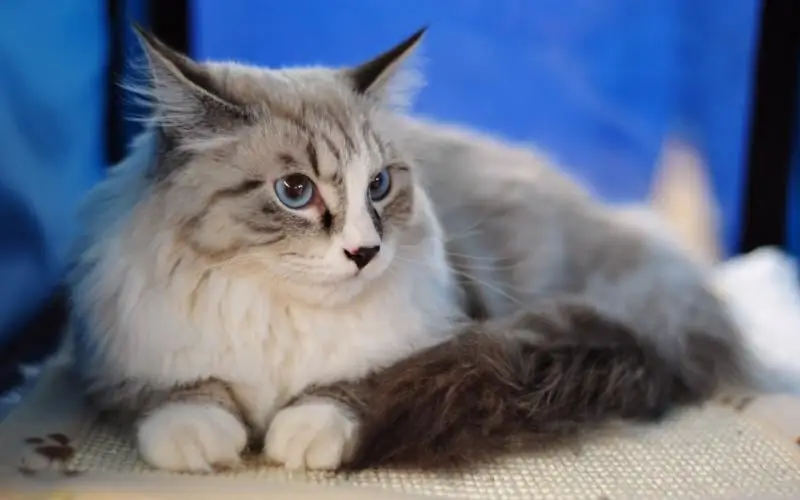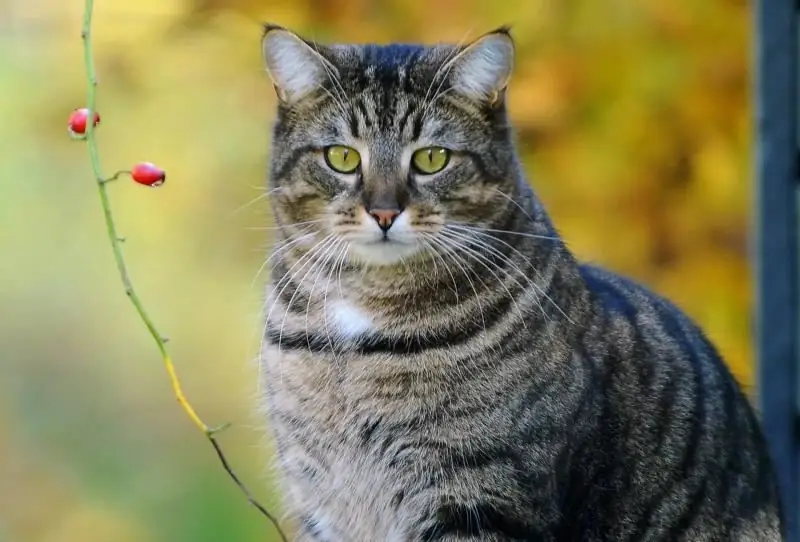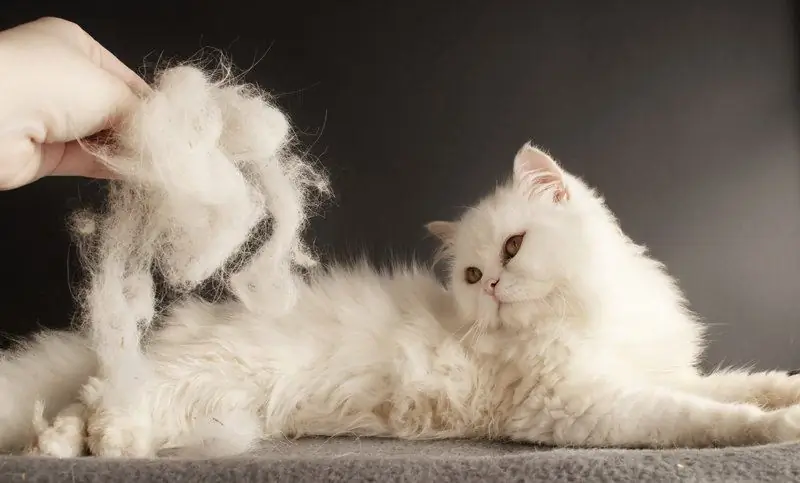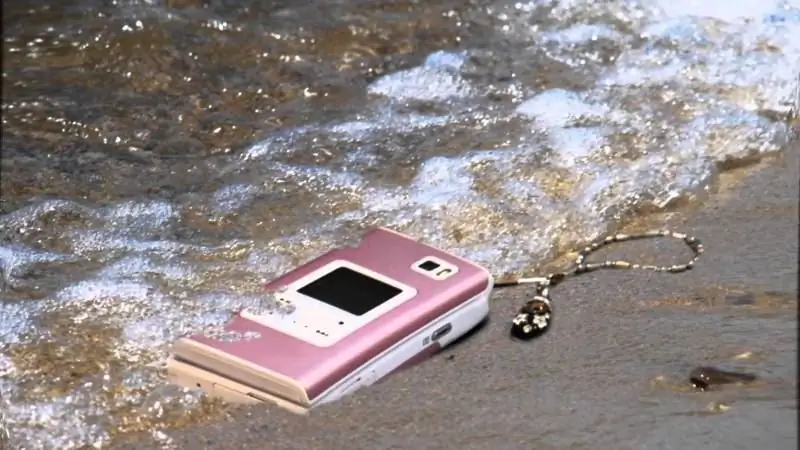
Table of contents:
- Author Bailey Albertson [email protected].
- Public 2023-12-17 12:53.
- Last modified 2025-06-01 07:32.
Drooling in a cat: what can cause a symptom

Drooling in cats can occur both as a normal physiological reaction and as a symptom of a lethal infection. In order for the owner to act correctly in a particular situation, one should be guided by the reasons that can cause this symptom.
Content
- 1 Manifestations of drooling in cats
-
2 Conditions for which increased salivation is normal
2.1 Video: Causes of Drooling in Cats
-
3 Hypersalivation as a sign of the disease
- 3.1 When you need to urgently contact your veterinarian
- 3.2 How to reduce salivation
-
4 Prevention of hypersalivation
4.1 Video: cat drooling - what to do
Drooling symptoms in cats
Hypersalivation (ptyalism) - increased production of saliva. In cats, it can occur both for physiological reasons that do not pose a danger and do not require the intervention of a veterinarian, or indicate the development of a pathological condition. The latter may be non-infectious - not posing a threat to the health of people and animals around it, or it may be dangerous.
Increased salivation can be expressed in the following symptoms:
- saliva flows out of the cat's mouth and drips onto the floor;
- the chin and paws of the cat become wet with saliva;
- the cat constantly swallows saliva;
- the cat rubs its muzzle against various objects;
- the cat often begins to wash and lick its fur;
- "icicles" appear on the wool due to the gluing of the hairs with saliva;
- wet spots remain where the cat has been recently;
-
tongue falls out of the mouth.

Drooling cat Drooling in a cat can be of varying degrees of intensity.
Conditions for which increased salivation is normal
There are situations in which increased saliva production is a physiological norm:
- in temperamental cats, drooling can cause communication with a beloved owner, for example, in sphinxes;
- while waiting for food, as well as from its appearance and smell;
- under stress - and its source may not be obvious to the owner (the appearance of a new person, animal in the environment, a change in the environment, a visit to a veterinary clinic), while the cat will nervously lick, over time, as the cat gets used to the changes, drooling passes;
- if the cat takes pills, their bitter taste, as well as an unpleasant aftertaste, can increase the production of saliva;
- when foreign bodies, large pieces of food get stuck in the cat's mouth, while the cat may be anxious, an attempt to help itself with its paws;
-
when teething in growing cats in the period from 3 to 6 months;

Doubling of canine teeth when changing teeth Hypersalivation is considered normal during the period of changing teeth in kittens.
- when irritating substances enter the mouth, which may include plant leaves and insects eaten by a playing cat;
- during motion sickness in transport.
Video: causes of drooling in cats
Hypersalivation as a sign of the disease
Hypersalivation can be observed both in diseases of the oral cavity and in systemic pathologies. An increase in salivation is caused by the following diseases of the oral cavity:
-
Gingivitis is an inflammatory process in the gum area that initially spreads to the mucous membrane near one or more teeth. With prolonged gingivitis, the inflammatory process can affect the periodontium and lead to tooth loss. Visually, pathology is defined as areas of reddening of the gums, sometimes with purulent or fibrinous membranes, regional lymph nodes - submandibular or parotid, can be enlarged, the cat behaves restlessly, it is possible to refuse solid food.

Gingivitis in a cat Gingivitis - inflammation of the gums, the disease can turn into periodontitis and lead to tooth loss
- Stomatitis is an extensive inflammation of the oral mucosa in cats. Areas of inflammation cover not only the gums, ulceration is possible. The onset of stomatitis in cats is often of an autoimmune nature, and the accompanying pathology with salivation is typical. Also, stomatitis is characterized by a pronounced pain syndrome, the cat refuses food and loses weight very much.
- Dental abscess - the appearance of a purulent cavity in the area of the tooth root, often occurs against the background of gingivitis, damage to the tooth enamel, as well as violations of the integrity of tissues in the projection of the roots of the teeth.
-
Mucocele (cyst of the salivary gland) - is formed when the salivary gland is damaged, for example, a stuck small bone or a small calculus formed in the duct of the gland, sialolith. In this case, there is an excessive accumulation of saliva in the tissues and ducts of the gland. It presses on the walls of the organ from the inside and permeates the surrounding tissues with the formation of an inflammatory granulomatous process, since saliva contains digestive enzymes, and also has an alkaline reaction, which further irritates the tissues. Mucocele looks like a volumetric mass in the mouth of a cat, located in the projection of the salivary gland.

Mucocele of the salivary gland in a cat With mucocele, saliva accumulates (cysts form) under the skin after damage to the salivary canals or glands
Common non-infectious diseases accompanied by salivation:
-
Formation of trichobezoars - with the accumulation of lumps of licked wool in the cat's digestive system, leading to a violation of the passage of food through the intestines, salivation occurs reflexively. Usually the condition coincides with the period of molting in the animal. Trichobezoars also appear:
- decreased appetite or complete refusal to feed;
- increased thirst;
- regurgitation of hairballs in the gastric contents;
- bloating;
- constipation, stool retention;
- the content of wool balls in the fecal masses.
-
Poisoning. Most often, salivation poisoning is caused by:
- eating poisonous plants;
- poisoning with poisons designed to combat rodents;
- preparations for treating cats from fleas and ticks when licking them from their fur;
- eating medications that attracted the cat by smell and taste;
- industrial chemicals and household chemicals in contact with a cat's coat and subsequent licking off it;
- poor quality, rancid, badly spoiled feed;
- mercury salts.
- An allergic reaction is an increase in salivation when an allergen enters the cat's mouth, while itching, rash, and other symptoms of hypersensitivity may appear.
- Metabolic disorders caused by liver or kidney disease. At the same time, the manifestations of salivation increase with a violation of the diet, as well as with exacerbations of the underlying disease.
- Tumor lesions localized in the head and neck, often lymphomas in cats.
Infectious diseases (infections, infestations) accompanied by salivation:
- Massive helminthic invasions.
- Feline viral leukemia is characterized by viral suppression of the immune system of cats with the formation of complex inflammatory reactions caused by the secondary flora on the mucous membranes of the digestive and respiratory systems. Stomatitis and gingivitis develop, which are resistant to treatment, which, in turn, cause salivation.
-
Other infectious diseases accompanied by damage to the oral mucosa, for example, calicivirus infection, which are characterized by:
- ulcerative lesions of the oral mucosa;
- fever;
- upper respiratory tract lesions - cough, sneezing, runny nose;
- conjunctivitis;
- pneumonia.
-
Rabies is the most dangerous cause of drooling. The factor provoking it is the reproduction of the rabies virus in the salivary glands of the infected animal. If rabies is suspected, the cat must be urgently isolated, and all contact persons must begin a course of immunoprophylaxis of the infection. If the diagnosis is confirmed, the cat will not be saved. The only protection of the animal is timely vaccination. With the disease, the following symptoms are observed simultaneously with salivation:
- inadequate reactions to habitual stimuli: fear, aggression;
- periodic convulsions;
- hydrophobia, aggravated by the sound of pouring or splashing water, as well as its appearance;
- the cat eating inedible items;
- changing the timbre of the voice;
-
paresis and paralysis, leading to changes in gait and habitual movements of the cat.

Cat rabies With rabies, the cat has profuse drooling
-
Aujeszky's disease (pseudorabies) is also a fatal infectious disease that cats contract when they eat raw pork meat. The disease is not spread from cat to cat or from cat to person. The causative agent is a virus, which is rare, but to which cats are very susceptible. In this disease, as in rabies, the central nervous system is affected with the development of non-purulent encephalitis, which is accompanied by profuse salivation. The development of the disease is more rapid than that of rabies. Also characteristic:
- fast weight loss;
- severe itching of the skin;
- the formation of paresis and paralysis with complete immobilization of the cat;
- death within 12-48 hours after the onset of clinical manifestations.
When you urgently need to contact the veterinarian
The signal for going to the doctor is the presence of profuse salivation in the cat against the background of:
- lack of connection with time, as well as environmental conditions;
- lack of an objective reason;
- different volumes of saliva separated in different episodes;
- strengthening dynamics;
- paroxysmal nature, and each time salivation lasts more than an hour and a half;
- the presence of other symptoms.

If the causes of hypersalivation are not obvious, and there are other symptoms, you should rush to the veterinarian
How to reduce salivation
A decrease in salivation is possible when the underlying cause that caused it is eliminated. The most easily eliminated factors are foreign bodies in the cat's mouth, which must be carefully examined, after putting on gloves. If it is not possible to independently establish and eliminate the cause of salivation, the animal should be taken to a veterinary clinic for examination. After examining the cat, the doctor may prescribe:
- X-ray of the skull to clarify the presence of abscesses and granulomas in the area of the roots of the teeth;
- biopsy of tissue altered by inflammation or tumor;
- general blood analysis;
- biochemical blood test to exclude metabolic causes of increased salivation;
- chest x-ray;
- X-ray of the abdominal cavity and esophagus with contrast to detect foreign bodies, tumors;
- analysis of feces for helminthic invasion.
After establishing the main diagnosis, the doctor will prescribe treatment, and with the elimination of the disease, salivation will normalize.
Prevention of hypersalivation
As measures for the prevention of hypersalivation, prevention of conditions that cause it should be considered:
- feeding the cat with quality food that does not contain sharp bones and other ingredients that can injure the salivary gland, as well as raw pig meat;
-
accustoming a cat from an early age to a regular toilet of the oral cavity, which includes its examination, brushing teeth, and also tongue;

Man brushing his teeth One of the important preventive measures is maintaining oral hygiene.
- storage of household chemicals, medicines, and other toxic substances in a place closed from the cat;
- prevention of licking of preparations for protection against fleas and ticks from the cat's fur (for this they are applied in places inaccessible for licking, more often the withers of the animal);
- preventing the cat from eating houseplants;
- annual rabies immunization;
- regular (once a quarter) treatment of a cat from worms;
-
combing a long-haired cat, feeding her Maltpasta during molting;

Maltpasta for cats Maltpasta helps to remove hairballs from the cat's digestive tract
- regular preventive examinations of the veterinarian;
- attentive attitude to the pet in order to notice the earliest signs of the disease in time.
Video: cat drooling - what to do
Hypersalivation is both a normal cat's reaction to an emotional or food stimulus, and a symptom of a number of pathological conditions, including rabies, a particularly dangerous infection. Of great importance for assessing the cause of hypersalivation are the circumstances in which it occurred, as well as assessing the general condition of the cat in terms of the presence of additional symptoms. Very often, salivation occurs with a foreign body in the mouth of a cat or a developing pathology of the oral cavity, which is easily diagnosed upon examination. If it is not possible to establish the cause, the cat needs a specialized examination in a veterinary clinic. When the underlying disease is eliminated, the symptom of which is hypersalivation, salivation is normalized. Preventive measures include taking proper care of your cat and taking care of its health.
Recommended:
The Washing Machine Does Not Drain Water - Why And What To Do In This Situation, Features Of Repairing Samsung, Indesit, LG And Other Companies, As Well As User Reviews

What to do if the washing machine does not drain water: solutions to the problem, features of repairing different models. Instructions with photos and videos
Why, Whether It Is Necessary And Why Not To Raise The Wipers In Winter - We Answer All Questions

Is it necessary to raise the wipers in winter? Reasons why experts do not recommend doing this
Dandruff In A Cat, Including On The Back Near The Tail: Causes Of Appearance, Diagnosis, Whether Treatment Is Necessary, Prevention Of Seborrhea, Reviews

What does dandruff look like in cats, its causes, diseases in which dandruff appears, treatment, prevention
Why Does A Cat Or Cat Shed Heavily And What To Do If The Hair Climbs And Falls Out In Large Quantities In A Kitten And An Adult Animal

How is molting in cats normal? Features in different breeds. How to help a cat with normal and prolonged molting. Diseases manifested by abundant molting
The Phone Fell Into The Water: What To Do, Including With An IPhone In The Toilet, If The Gadget Does Not Turn On, The Speaker Does Not Work

What to do if your phone falls into the water: instructions for saving your phone. Features for different models. Frequent misconceptions. Possible problems after drying
